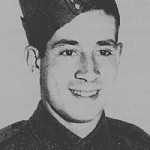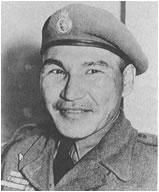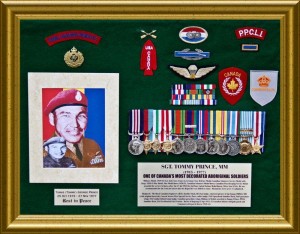Canada's Forgotten Warriors
 Soldiers of aboriginal blood have served valiantly for Canada in all of her wars. Yet their contributions have often been overlooked or forgotten.
Soldiers of aboriginal blood have served valiantly for Canada in all of her wars. Yet their contributions have often been overlooked or forgotten.
As a new year begins, what better time to recall soldiers of aboriginal blood, who have served valiantly for Canada in all of our wars and campaigns.
In a tribute article last Remembrance Day, the National Post ran a full page on Canada’s famous “native warriors” who served in our wars in greater numbers than their population warranted.
They were generally treated better in the army — i.e. as equals and without prejudice — than they were when they returned to civilian life after the two world wars and Korea .
Canada’s most renowned soldier of aboriginal blood was Tommy Prince, who won a Military Medal (MM) in Italy during the Second World War, and later was awarded the U.S. Silver Star.
He served throughout the Korean War and on retirement had a dozen medals — 10 of them campaign medals.
Civilians tend to be impressed by the numbers of medals worn. Soldiers or veterans revere valor decorations. Campaign medals are for being there, not for doing anything special.
When I was intelligence officer of the Princess Pats towards the end of the Korean War, Sgt. Prince and his snipers were under my command.
He had arthritic knees and was winding down, but had universal respect from every soldier in the battalion. Tommy never rejected or disputed an assignment.
When he died homeless, on the streets of Winnipeg in 1977, old comrades mourned and eventually schools, streets, parks and scholarships were set up in his name — for all the good it did him.
As much as he was respected, Tommy Prince was not Canada’s most decorated soldier of aboriginal blood in the Second World War. That honor goes to another — Charlie Byce, who joined the Lake Superior Regiment and won the MM on a prisoner-taking raid across the Maas River in 1945.
His commanding officer was a family friend — Lt.-Col. Bob Keane — whom I remember after the war recalling that he’d recommended one soldier for a Victoria Cross.
That soldier was Charlie Byce, whose valor citation was initialed all the way up the chain of command, through corps commander Lt.-Gen. Guy Simonds, to army commander Gen. Harry Crerar, to Field Marshal Bernard Montgomery.
As occasionally happened, Byce’s VC recommendation was “downgraded” to a Distinguished Conduct Medal (DCM), a bravery award second only to the VC.
Speculation by some was that since he had aboriginal blood, Byce was denied the VC.
A more plausible reason was that the operation he was involved in was not a success, but a narrowly averted disaster.
In a battalion attack in March, 1945, in the Hochwald Forest, Byce became something of a legend in the Lake Sups.
As an acting sergeant, he led “C” company when every superior officer became a casualty, and all the unit’s tanks were hit.
Enduring considerable casualties, Byce routed the Germans from their position at some farmhouses. Personally rallying the men amid severe casualties, Byce and his men not only held the position but broke repeated German attacks.
Byce personally destroyed a Tiger tank with a PIAT antitank gun, then directed fire that routed the German infantry following the tank.
Using grenades, he cleared the farmhouses, but had no antitank ammunition when more Tigers moved in.
By mid-afternoon when he had to withdraw, Byce stayed behind in a sniper’s role while his men evacuated their wounded and fell back. In a sniper’s role Byce halted the enemy by picking off 18 Germans before successfully withdrawing himself. He was 24 at the time.
His lengthy DCM citation reads: “The magnificent courage and fighting spirit displayed by this NCO when faced with almost insuperable odds are beyond praise. His gallant stand, without adequate weapons and with a bare handful of men against hopeless odds will remain, for all time, an outstanding example to all ranks of the regiment.”
If that isn’t a citation worthy of a VC, nothing is.
Interestingly, Byce’s father won a DCM in the First World War, and was also awarded the Medaille Militaire — France’s second highest valor award. Today, both father and son’s medals reside in Ottawa’s National War Museum .
Canada’s most decorated aboriginal is an amazing sniper in the First World War — Francis “Peggy” Pegahmagabow, an Ojibway sniper who stopped counting after knocking off 378 Germans and winning the Military Medal (MM) and two bars — to this day, the greatest number of battle awards won by any Indian or Metis.
Charlie Byce, died in 1994 at age 74, his wartime exploits largely unknown except for veterans of his regiment. His brother is a retired Presbyterian minister in Toronto, his sons and daughter scattered across the country.
He is another forgotten Canadian, who deserved better, and whose wartime legacy now resides in the National War Museum with others of aboriginal blood like Tommy Prince, Peggy Pegahmagabow and Henry Norwest. Exalted company.
Peter Worthington is the founding editor of the Toronto Sun. He was Canada's youngest officer in the Fleet Naval Air Arm during World War Two and served in Korea as a platoon commander, intelligence officer and aerial observer.




